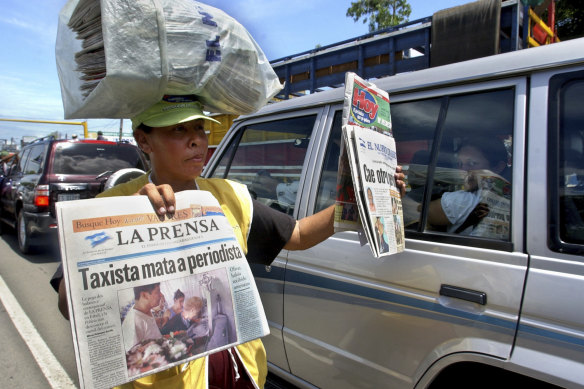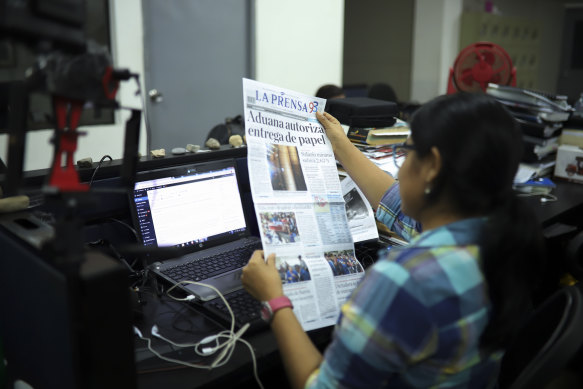- World
- Central America
- Press freedom
This was published 4 years ago
Nicaragua lifts newsprint ban on embattled La Prensa newspaper
By Ismael Lòpez Ocampo and Mary Beth Sheridan
Managua: Nicaraguan authorities have lifted their 18-month blockade of newsprint to the country's best-known daily, La Prensa, a restriction that had threatened to strangle the publication and leave the country with no newspapers.
"The newsprint has been liberated!" read the headline on Saturday's front page, with a photo of its director, Jaime Chamorro, in front of enormous rolls of newsprint.

The government of President Daniel Ortega has allowed printing supplies belonging to La Prensa to be released from customs after retaining them for 18 months.Credit: AP
La Prensa's editors had protested that newsprint and other imported supplies had been held up in customs in retaliation for its coverage of anti-government demonstrations in 2018. More than 326 people were killed in those protests, most at the hands of police, according to human-rights organisations.
After the protests, President Daniel Ortega's government led one of the most severe crackdowns on independent media in the hemisphere, raiding news organisations and imprisoning reporters. Scores of journalists have gone into exile.
On Friday, authorities released the newsprint without explanation. A government spokesman didn't respond to a message seeking comment.
"We're going to get the presses rolling again," Chamorro said, as the rolls of paper arrived at La Prensa.

A journalist holds up a copy of La Prensa independent newspaper with a headline that reads in Spanish; "Customs authorises release of printing paper," on Friday.Credit: AP
He told reporters that the apostolic nuncio in Nicaragua, Archbishop Waldemar Stanislaw Sommertag, had called him with the news that the customs office had decided to hand over the paper. Sommertag has mediated talks between the opposition and government.
"I don't know why, I don't know what moved the presidency," said Chamorro. He said he had been told the decision came from Rosario Murillo, Ortega's wife, who is vice president.
La Prensa is one of the most storied newspapers in Latin America. In 1978, its editor, Pedro Joaquin Chamorro, was gunned down in Managua, sparking the revolution that brought the left-wing Sandinista guerrillas to power. The paper went on to become a prominent critic of the Sandinistas and their leader, Ortega. He returned to the presidency in 2007 and has been re-elected twice.
Crippled by the lack of newsprint, La Prensa's owners have reduced the paper from 36 to eight pages, and turned to printing it on regular paper - a move that elevated its costs by 30 per cent, according to Chamorro.
In January 2019, the newspaper published an edition whose front page was blank except for a question: Have you imagined living without information?
Another major newspaper, El Nuevo Diario, shut down last fall after complaining that the government had blocked its imports of newsprint.
Michael Kozak, the US undersecretary of state for Latin America, tweeted: "The long-overdue decision to release @laprensa's paper & ink from Nicaraguan customs is a step in the right direction." He added that Ortega should return property confiscated from other independent media outlets, like the news site Confidencial and the cable TV station 100 Noticias.
Even with the restoration of La Prensa's newsprint supply, the 94-year-old daily is struggling to survive. Nicaragua's economy tumbled into recession after the political turmoil in 2018, complicating the newspaper's situation.
"Our newsroom had 100 journalists in April 2018. Currently we have 25 working on the two newspapers we produce," said editor in chief Eduardo Enríquez, referring to La Prensa and the tabloid Hoy.
The Washington Post